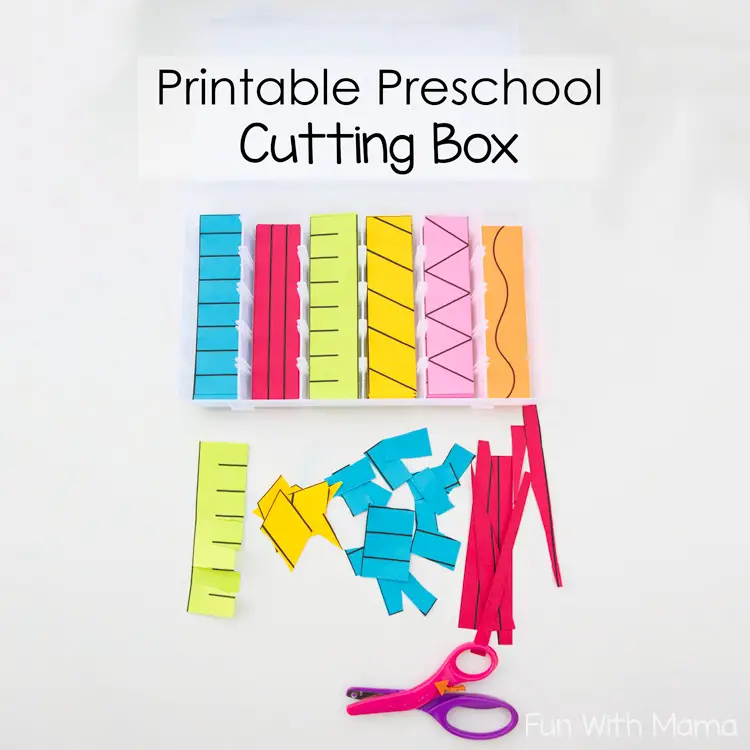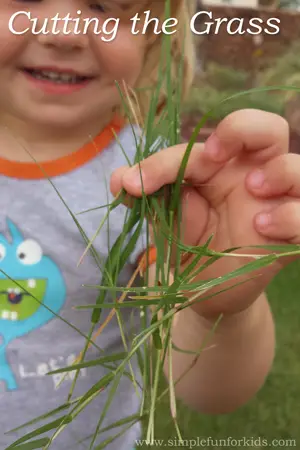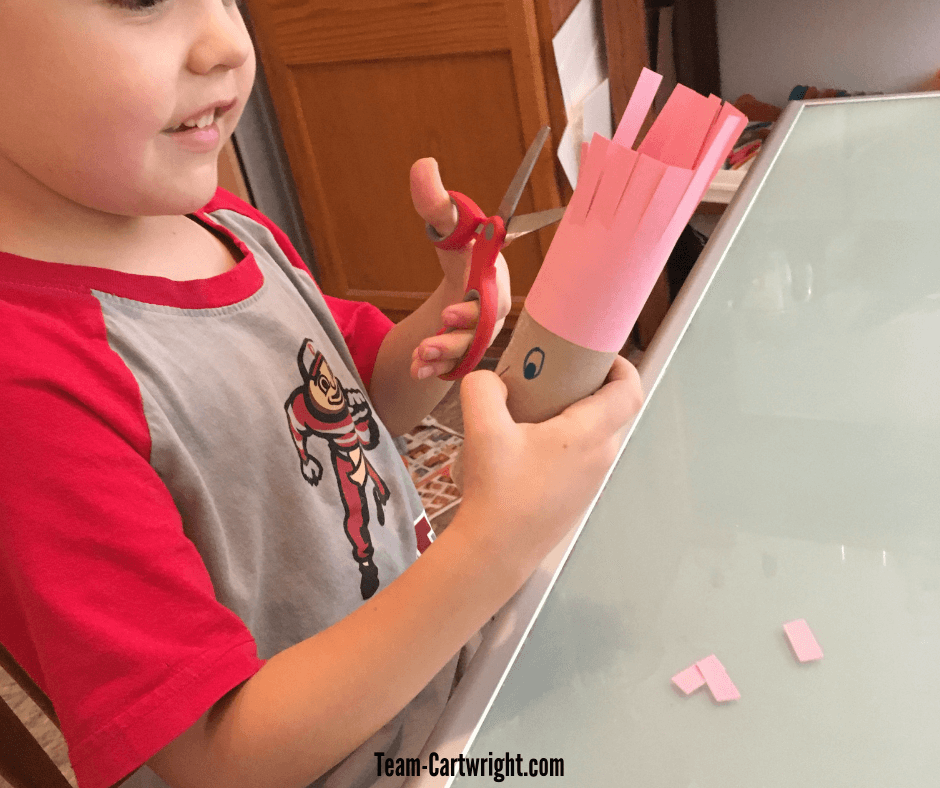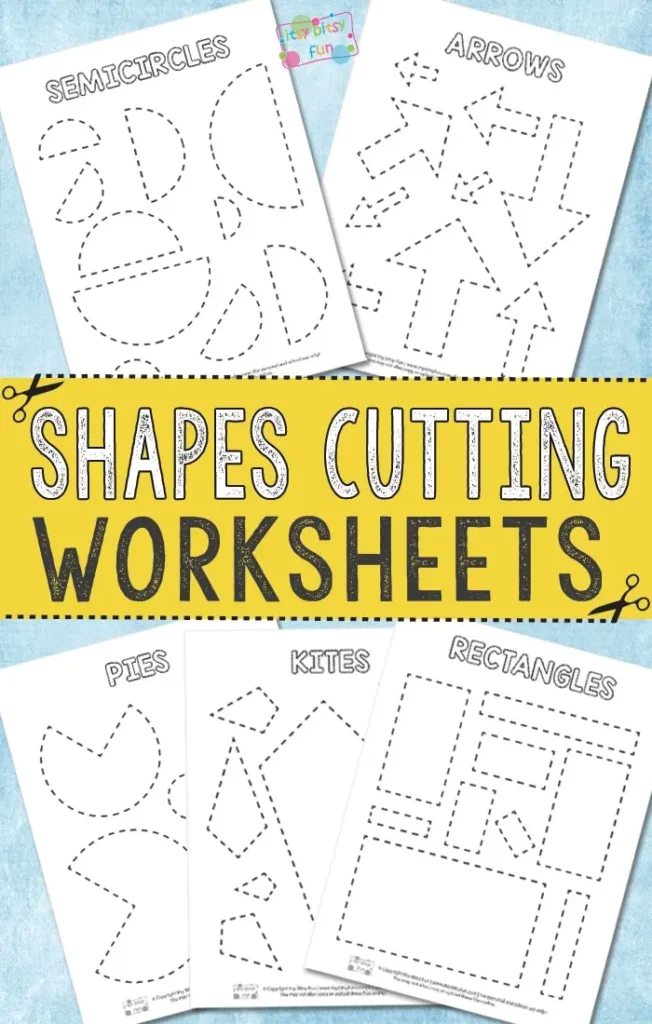Using scissors efficiently is one of the crucial skills to learn in preschool. Cutting is a skill taught early and requires a lot of practice for mastery. It requires solid hand strength and coordination.
Make this task fun and engaging. Here are ten activities to help children with their cutting skills.

These cutting activities include different lines for children to practice. This activity is Montessori-inspired, with strips of paper with lines printed on them.
Children can cut the lines depending on their scissors skills, improving fine motor and hand-eye coordination skills.
Download and print the free templates for cutting on the site. Print them on colored cardstock and use the guillotine paper cutter to separate them into strips. If this paper cutter is unavailable, use scissors or a box cutter and ruler.
Once the pieces are cut, organize them in a plastic box with dividers. Use regular shoe boxes or trays if unavailable.
Provide children with scissors with the instruction to cut on the line. Decide which type of lines children will cut. Short straight lines are the easiest to work on. Children can practice on these until they are comfortable enough to cut diagonal and wavy lines.
Provide a container for all the pieces they cut up. This activity is great for centers. Provide different types of scissors that children are comfortable using.
For this activity, you will need:
- Printed cutting templates
- Colored cardstock
- Preschool scissors
- Organizer box
- Guillotine paper cutter
For more information on this activity, go to FunWithMama.com.

Playdough cutting is one way to strengthen the finger muscles of children. Cutting requires hand coordination, which can be achieved if the fingers are strong enough to hold the scissors and keep them in place.
Cutting a thick material such as playdough will provide awareness among children with the precise movement and enough pressure required to separate this clay into pieces.
This cutting activity is perfect for young children just learning to use scissors. This activity will enhance their fine motor skills and make their hands stronger.
Have the children take the play dough out of the tub. Let them flatten it, roll it into a log, or use different types of accessories to add designs to it. Children may use patterned rolling pins or shape them using cookie cutters.
Demonstrate how children should use the scissors by showing which fingers should go into the holes. Let children mimic the open and close movement while holding the scissors.
Praise every attempt and reward them at the end of the task.
For this activity, you will need:
- Plastic scissors for playdough
- Playdough
- Playdough accessories
- Scissors
For more information on this activity, go to TeachingLittles.com.

This activity is a great way to incorporate nature with fine motor skills. Bring the classroom outside as they cut the grass in the garden. Let children enjoy grass cutting and explain that grass needs to be trimmed regularly to make the lawns tidy.
Choose the correct type of scissors for children in this activity. Avoid those with sharp and pointy edges to prevent accidents. If children are hesitant to cut grass on the ground, provide pre-cut grass.
Extend this fine motor activity with pretend play. Tell children that they are harvesting crops and need food to feed their families. Have them take the cut grass and use it in the play area for cooking.
To do this, provide scissors to children and let them cut the grass. If possible, give a container for each child to place their cut grass. Let them race as they fill their containers full.
If there are no gardens available or the child cannot go outdoors, pick up dried leaves from the sidewalks or parks and use these as an alternative.
For this activity, you will need:
- Scissors
- Grass
For more information on this activity, go to SimpleFunForKids.com.

There are many ways to make the cutting activity appealing to young children. One of these is to provide different materials for children to cut regularly.
Children will be excited to cut the materials and improve their fine motor skills by varying the materials.
For this cutting activity, provide sensory bins for young learners to practice their cutting. Use a tub or tray filled with materials for cutting; it should be big enough to hold the cut pieces inside.
The site recommends ribbons, shredded paper, playdough, slime, tape, straws, streamers, paint samples, paper strips, and gift wrappers.
Children can also practice cutting different lines, such as short and long straight lines, wavy lines, diagonal lines, and zigzag lines. They can also practice cutting out shapes, pictures, and magazine letters.
Engaging in craft activities that require cutting is also an excellent way to practice scissors skills.
Include the right scissors in the tub, depending on the child’s skills. Use grip, safety, and blunt scissors for beginners.
For this activity, you will need:
- Scissors
- Tub or large container
- Materials for cutting
For more information on this activity, go to PocketOfPreschool.com.

There’s no better way to hone fine motor skills than with an interactive story where the child gets to be the hero in the process. Children will have a fun time as they take on this mission impossible of rescuing the bears one at a time.
Trap the bears by placing them in the muffin tin. Place one or more in each cup. Place a single strip of painter’s tape horizontally and another vertically.
Cut the tape long enough to stick the edges on the back part of the pan. This step will secure the painter’s tape and will hold onto the pan well while the children cut them.
Doing this will create a grid on the muffin pan, and children will have to cut twice to free the bear in each cup. Reward the children once they have released all the bears.
If counting bears are unavailable, use other small items that will fit inside the muffin tin cups, such as marbles or cut-out pictures of animals.
For this activity, you will need:
- Blunt-edged scissors
- Counting bears
- Muffin tins
- Painter’s tape
For more information on this activity, go to DaysWithGrey.com.

Who doesn’t love jelly? Whether made from scratch or ready to eat in containers, the jelly has a texture that provides a great sensory experience for young learners.
Jelly is an excellent material for children learning to cut because it is soft and does not require too much pressure as they use scissors. This will help them practice the opening and closing movements when cutting.
To use these as cutting materials, provide children with a bowl of jelly to cut. Let them cut these in different ways-cut in big chunks or snip them into small pieces. Use a separate bowl for each output.
The smell and soft texture excite children as they do the task. Make this activity more challenging by using time as a factor.
A group of children may race to see who can finish the fastest. One may also challenge the fastest by attempting to beat the record time.
For individual tasks, place a single color of jelly in a bowl. Find out how fast the child can cut the first bowl of jelly. Repeat the process with a different color.
For this activity, you will need:
- A bowl of jelly
- Scissors
For more information on this activity, go to NurtureStore.co.uk.

As the sun helps plants grow, this sun craft helps children improve their cutting skills. This activity is a great cutting practice and control of scissors for children. All they have to do is make the sun’s rays by snipping off the outer part of the sun.
Make three kinds of suns for children to cut. The site recommends different sizes of fringes to practice cutting. Use regular yellow paper or cardstock if the craft foam is unavailable.
Make the sun by tracing a plate on the craft foam to make the circle. Trace a second circle inside the big one. Use a smaller item such as a saucer or bowl. Next, cut out the outline of the big circle.
Repeat the process using different sizes of objects for tracing. Limit the space between the two circles for the different sizes of fringes.
Instruct children to cut from the edge and stop on the red line. They will need to repeat until the entire sun has fringes. For younger children, draw a line for the fringes they will cut as a guide.
For this activity, you will need:
- Scissors
- Yellow craft foam
- Circle objects for tracing, such as plates and bowls
- Marker
For more information on this activity, go to ADabOfGlueWillDo.com.

This cutting craft is so versatile it can be used for different occasions. Use a green instead of a red hat to make a leprechaun perfect for St. Patrick’s Day.
Put a crown on the face in place of the hat to make King Triton. This is an excellent activity for Disney-themed lessons.
Children will have fun cutting the beards of these Santas while improving their scissor skills. They will work on different lines to cut depending on their skills.
Cut circles from skin-colored construction paper of different shades to make the Santa. Draw the facial parts, such as the eyes, nose, and mouth.
Next, use red and white construction paper to make the hats. Cut a triangle shape wide enough to fit the whole top part of the head. Add a white paper cut out for the bottom edge. Stick a cotton ball on top of the red hat.
Place the hat on Santa. Next, make the beard by drawing lines on white paper, such as straight, wavy, zigzag, and others. Attach these to the Santas.
Stick the Santas on the wall and let the children cut them.
For this activity, you will need:
- Construction paper
- Black marker
- Cotton balls
- Scissors
For more information on this activity, go to HappyToddlerPlaytime.com.

Let children become barbers or hairdressers as they practice cutting hair made from paper to improve hand control and coordination. This is a great setup in the pretend play center.
Include other necessities such as the barber’s apron and hairbrush to complete the look. Use this craft to go with hair-cutting songs and rhymes. Once the hair is trimmed close to the edge, replace the paper hair, and it’s ready to use again.
Take a toilet paper roll and use the markers to draw the facial parts-eyes, nose, and mouth. Use sticky tape to keep the construction paper inside the roll. Cut long strips to resemble hair. Have the child cut the client’s hair.
Modify this craft by adding beards on the toilet paper face. Stick an extra paper on the opposite edge of the roll and have the children trim it.
Change the hair’s texture using a pencil to curl the ends of the strips to make curly hair. Change the color of the paper hair to represent the children in the class.
For this activity, you will need:
- Toilet paper roll
- Markers
- Scissors
- Construction paper
- Sticky tape
- Scissors
For more information on this activity, go to TeamCartwright.com.

Provide more challenging tasks for older children with this set of cutting exercises. Children may work on these different shapes to practice using two hands, scissors control, and eye-hand coordination.
There are twenty pages to choose from in these free printables. Each page has a shape that comes in different sizes for children to cut.
These can be colored and designed before cutting and glued together to form images such as a robot for the rectangle printable.
Children can also choose which pieces to cut to form a picture. For example, to make a house, the child may cut a huge triangle and rectangle for the roof and walls, small squares for the windows, and a small rectangle for the door.
Let the children color, cut, and assemble these shapes by gluing them on paper.
Download and print the free printables from the site. Give children the scissors and let them cut all the shapes on each page or choose the shape that they prefer cutting.
For this activity, you will need:
- Printed shapes cutting printables
- Scissors
For more information on this activity, go to ItsyBitsyFun.com.
See also: Shapes Charts for Preschool
Conclusion
Cutting skills need not be a burden for young children with these activities. Choose an activity from the list that children will likely enjoy the most and that will fit your lesson and theme.
Consider these activities to help children improve their ability to use the scissors efficiently. Thank you for reading!
People Also Ask
Learning to cut is one of the fundamental skills taught in preschool. Children can find value in these skills as they participate in activities requiring them to use scissors.
Many activities can be engaging and encourage children reluctant to use scissors. Always praise children as they engage in this activity. This will motivate them to keep on practicing to improve their skills.
There are different ways to teach children to cut. Use fun activities such as cutting centers and making crafts. They can also be cut during a cooking activity. Allow them to cut herbs and leafy vegetables using scissors.
Use different materials to make the cutting activity fun and exciting for children. Remember to use the right scissors for the right skills and vary the type of materials children will cut to improve their ability to control the scissors.
Being able to cut with scissors is an essential skill for children. As they repeatedly do this task, they become more skilled with controlling the scissors, their hand muscles become stronger, and their ability to stay focused on tasks is enhanced.
Cutting is also a foundational skill for writing. Children can control writing implements like pencils and markers if they can handle scissors well.
See more fun and engaging activities for your little ones.






